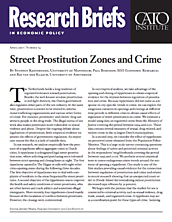The Netherlands holds a long tradition of regulated tolerance toward prostitution. Besides the well-known window prostitution in red-light districts, the Dutch government also regulates other parts of the sex industry. At the same time, prostitution is known to be related to international trafficking organizations and various other forms of crime. For instance, prostitutes’ and clients’ drug use attracts people in the drug trade. The illegal status of sex work also makes prostitutes more vulnerable to sexual violence and abuse. Despite the ongoing debate about legalization of prostitution, little empirical evidence examines the effects of government regulation. An important reason for this is a lack of suitable data.
In our research, we analyze empirically how the presence of a tippelzone affects aggregate crime in Dutch cities. A tippelzone is a designated legal street prostitution zone, where soliciting and purchasing sex is tolerated between strict opening and closing hours at night. The first tippelzone opened in The Hague in 1983 with eight other cities opening zones during the following three decades. The first objective of tippelzones was to deal with complaints of residents in the areas frequented by street prostitutes.
A second objective of the tippelzones was to improve the health and safety conditions of street prostitutes, who are often heroin and crack addicts and sometimes illegal immigrants. More recently, four tippelzones closed mainly because of the escalation of conflicts between prostitutes. However, the closings were controversial.
In our empirical analysis, we take advantage of the opening and closing of tippelzones to obtain empirical evidence for the relation between regulation of prostitution and crime. Because tippelzones did not come as a response to city-specific trends in crime, we can exploit the exogenous variation in openings and closings at different time periods in different cities to obtain causal effects of regulation of street prostitution on crime. We estimate a model using data on registered crime from the Ministry of Justice covering the period between 1994 and 2011. These data contain several measures of sexual, drug-related, and violent crime in the 25 largest Dutch municipalities.
In a second step, we consider the effect of tippelzones on perceived crime obtained from the Population Police Monitor. This is a large-scale survey containing questions about feelings of safety and perceived criminal activity in the respondents’ neighborhoods covering the period between 1993 and 2006. We perform several empirical tests to assess endogenous crime trends around the moment of opening a tippelzone. Our study is one of the first studies providing causal evidence for the connection between regulation of prostitution and crime and relates to recent research showing that an unexpected court order in Rhode Island decriminalizing indoor prostitution decreased rape offenses by 31 percent.
We begin with the premise that the market for sex is connected to criminal activity, such as sexual violence, drug trade, assault, and organized crime. A tippelzone may act as a coordination point for these types of crime. Isolating street prostitutes within a delimited area attracts individuals prone to sexual violence and drug dealers, which in turn attracts new drug addicts and dealers. However, police monitoring is higher in tippelzones than in other areas of the city, so criminals of all types—sex traffickers, pimps, drug dealers, and violent clients—must trade off their willingness to operate in the tippelzone with the higher risk of apprehension. Indeed, upon the closing of tippelzones, supporters of the zones claimed that neither street prostitution nor its surrounding crime would disappear, but that both would simply spread around the city and become less manageable. The intense debate between supporters and opponents of tippelzones emphasizes the need to supplement theoretical models on prostitution and crime spillovers with empirical results.
Another argument in favor of tippelzones is that criminalization of prostitution forces the sex industry into the illegal underground market. Two alternatives to criminalization are to fully legalize prostitution or to legalize it but restrict access to a limited segment of people using licenses. A unique feature of our analysis is that we can study both systems. Some tippelzones allowed free entry, while others enforced a licensing system immediately or introduced it after some years.
Our empirical results show that opening a tippelzone reduces sexual abuse and rape. These results are mainly driven by a 30–40 percent reduction in the first two years after opening the tippelzone. For tippelzones with a licensing system, we additionally find long-term decreases in sexual assault and a 25 percent decrease in drug-related crime, which persists in the medium to long run. We do not find evidence for effects on other types of crime, such as violent assaults and possession of illegal weapons.
We compare these effects on registered crime with those on perceived crime. Because policy decisions are heavily influenced by public perception, it is relevant to know whether these perceptions are in line with registered crime. Our results indicate that perceived drug nuisance increases by approximately 6 percentage points when a tippelzone is opened. These effects, however, vary depending upon the proximity to the tippelzone and whether the tippelzone enforced licensing from the start. For cities where licensing was introduced immediately, we find some indication that tippelzones achieved their stated goal to reduce the nuisance created by drug-addicted prostitutes and their followers overall in the city. This success, however, came at the expense of residents living close to tippelzones.
NOTE:
This research brief is based on Stephen Kastoryano, Paul Bisschop, and Bas van der Klaauw, “Street Prostitution Zones and Crime,” April 30, 2015, https://papers.ssrn.com/sol3/papers.cfm?abstract_id=2606891.
